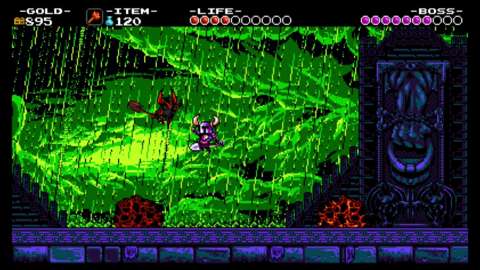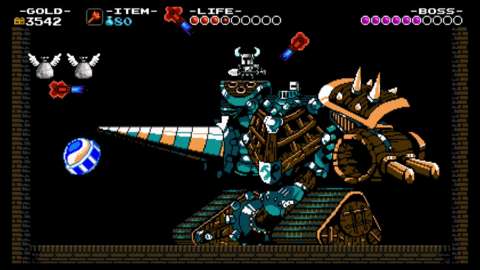Calling Shovel Knight "old-fashioned" isn't derogatory. Rather, its brazen re-creation of established conventions only proves that some ideas, no matter how dusty they may appear, are engaging no matter what era we're in. There's no expiration date on immediate combat in which smart positioning is as important as deft attacks, or branching stages that hide secret passageways for those anxious to quench their inquisitive flames. Shovel Knight doesn't add anything novel over what we've seen in countless older games; it doesn't reinvent its core concepts into a decidedly new experience. Rather, it shows just how exciting a traditional adventure can still be, making technological innovations seem superfluous when pure fun is all you crave.
Everything in Shovel Knight can be classified as old in one way or another. The story, in which two fearsome knights are separated by a malevolent force and one (the man) must rescue the other (the woman), belongs to a bygone era. Simple aesthetics owe much to the visual design and musical scores from when sprites and MIDI were still the dominant forms of artistic expression. And beyond those surface details lie references to the progenitors of Shovel Knight's exploits. The knights who serve as bosses borrow heavily from the robot masters of the Mega Man series, complete with their own descriptive quirks that dictate not only their attacks, but the traps populating their stages. Towns that you duck into could have been pulled from Zelda II: The Adventure of Link (though there is thankfully no one named Error present). And you'd be forgiven for mistaking your pogo attack for Scrooge McDuck's from DuckTales.
Rather than relying on conjuring pleasant memories from a simpler time, however, Shovel Knight is fun because its many components are well realized. Take the combat as an example of where Shovel Knight proves its worth based on its own merits. Combat is position-based because knockbacks are so prevalent. Not only can enemies shove you into bottomless pits with a timely attack, but striking baddies with your shovel also nudges you toward the void. It's a system that demands careful planning even though your repertoire is limited. Attack too soon or late, and you're liable to meet an untimely end, so the precision needed to survive unscathed pulls you in to the life-or-death showdowns.
Some ideas, no matter how dusty they may appear, are engaging no matter what era we're in.
Pits are the number one danger you face. Mistiming a jump is a common occurrence, especially when there are enemies waiting for you to make a mistake, so the majority of my failures came from careless stumbling. Generous checkpoints ensure backtracking is kept to a minimum, and though this eliminated frustration, the prevalence of safety nets meant I was rarely forced to alter my strategy. Mere competence is enough to get from one checkpoint to the next, which was disheartening considering how punishing similar games have been. It's difficult to strike that balance between challenge and accessibility, and Shovel Knight leans a little too far to the latter side.

Whining that Shovel Knight is slightly too easy doesn't seem fair considering how much I enjoyed venturing through every stage. However, because I so rarely feared for my life, I never felt the need to master every item that I unlocked. Sure, I could have made clever use of my invincibility cloak, or figured out a way to use a thunderous punch mid-battle, but there was no need to delve deeper into my tactics. I relied on my standard strike, pogo attack, and fireball for much of the adventure, so though puzzling out how best to defeat each foe was still enjoyable, any variety was my own doing rather than the game's demand. That sadly remained unchanged even in New Game Plus. Patience and precision are enough to vanquish any stage, so much of my inventory remained unused, and my strategy never wavered.
These problems didn't become apparent until I revisited stages. Games cut from a retro cloth tend to hold my attention for dozens of hours as I hunt down every secret and master the many confrontations. But there was no such draw here. Still, during my first time through, the stages were fluid and dynamic, presenting so many architectural and adversarial changes that I was continually enraptured. Seeing disinterested hamsters attached to propellers made me laugh with joy, and matching wits against shield-bearing knights provided many humbling outcomes. Braving the darkness of one level and the wind of another demanded different skills, and never knowing what awaited me in the next screen kept me slightly unhinged. What madness would be expected of me? Would I have to eliminate the spirits haunting a house? Or navigate platforms while magma poured from above? Shovel Knight's bountiful charms are so immediate and satisfying that I couldn't stop myself from forging ahead to see what else lay before me.
The branching level design also beckoned. Shovel Knight is strictly linear, except if you have an inquisitive nature. False walls give way to myriad places where bountiful treasure is stored. A sharp-eyed individual should find half of what's out there the first time through, but even after visiting each stage multiple times, there were still a handful of tricky items that I couldn't locate. The reward for uncovering a secret is mostly intangible--the money from treasure chests doesn't matter once there's nothing else to buy--and though I drew great joy from trying to secure every bit of treasure initially, my interest waned as time elapsed. The core action wasn't as exciting on repeat visits. With so few surprises waiting for me, and no need to vary my strategies, I was lulled by predictability.

So, Shovel Knight doesn't hold up upon a second and third playthrough. That's a black mark if you're keen on starting fresh after the credits role, but there's no shame in lessened impact on repeat visits. There is one element that remained gripping no matter how often I played it, though: boss fights. These are pattern-based affairs that test your reaction time, punish your recklessness, and make you feel incredibly powerful once you come out on top. These encounters are the one situation that I had to make use of my expansive inventory as I searched for an item that would give me the upper hand. I would toss deadly balls to deal massive damage, use a magic sword to glide through the air unscathed, and turn invincible when I needed a breather. And when the difficulty ramped up in New Game Plus, I was brought to my knees more often than I’d like to admit.
No matter which era it had been released in, Shovel Knight would have been embraced. Its inherent charms are timeless. Shovel Knight is a good reminder that game design does age but can never die and that simple mechanics can still be immensely satisfying. But this is not another classic. History echoes forth in everything that Shovel Knight does, but while its inspirations offer compelling moments decades after they were first released, this adventure loses its impact all too quickly. Much of what draws me to games of this ilk are repeatedly playing through them, differing my tactics to become more efficient at whatever challenges lie before me. Without that aspect present in Shovel Knight, I was left with an "is that all?" feeling when the well ran dry. Shovel Knight is a memorable re-imagining of what I grew up with, but doesn't have the longevity or inventiveness to be great in its own right.